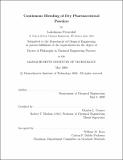Continuous blending of dry pharmaceutical powders
Author(s)
Pernenkil, Lakshman
DownloadFull printable version (7.845Mb)
Other Contributors
Massachusetts Institute of Technology. Dept. of Chemical Engineering.
Advisor
Charles L. Cooney.
Terms of use
Metadata
Show full item recordAbstract
Conventional batch blending of pharmaceutical powders coupled with long quality analysis times increases the production cycle time leading to strained cash flows. Also, scale-up issues faced in process development causes delays in transforming a drug in research to a drug under commercial production. Continuous blending is as an attractive alternative design choice to batch process and is examined in this work. This work proposes to examine the feasibility of applying continuous blending in pharmaceutical manufacturing. Two kinds of blenders, a double helical ribbon blender and a Zigzag R blender were chosen as experimental systems representing high shear and moderate shear equipment. This work first focuses on developing a process understanding of continuous blending by examining the ow behavior of powders in experimental blenders using impulse stimulus response experiments and subsequent residence time distribution analysis. Powder ow behavior was modeled using an residence time distribution models like axial dispersion models. These ow behavior studies were followed by blender performance studies. The dependence of the mixing performance of the continuous blending system on different operational variables like rotation rates of mixing elements and raw material properties like particle size, shape and cohesion were studied. Mean residence time and time period of fluctuation in the concentration of active ingredient coming at the inlet were the two most important operational variables that affected blender performance. Larger particles and particles with less cohesion were seen to mix well with higher dispersion coefficients in a ribbon blender. A residence time distribution based process model for continuous blending was investigated and shown to depict the process well within experimental errors in determining the parameters of the residence time distribution model. (cont.) The predictive capability of the process model was found to dependent on the scale of scrutiny of the powder mixture in the blender. Choosing the correct scale of scrutiny was demonstrated to be of critical importance in determination of blend quality. Growing pressures on pharmaceutical industry due to patent expirations has forced manufacturers to look beyond the US and EU for potential manufacturing locations in addition to invest in novel manufacturing methods and technologies. The capstone work in this thesis proposes a framework that managers of pharmaceutical and biologics manufacturing can utilize to identify critical issues in globalization of manufacturing and in making strategic manufacturing location decisions.
Description
Thesis (Ph. D.)--Massachusetts Institute of Technology, Dept. of Chemical Engineering, 2008. This electronic version was submitted by the student author. The certified thesis is available in the Institute Archives and Special Collections. Includes bibliographical references (p. 269-279).
Date issued
2008Department
Massachusetts Institute of Technology. Department of Chemical EngineeringPublisher
Massachusetts Institute of Technology
Keywords
Chemical Engineering.